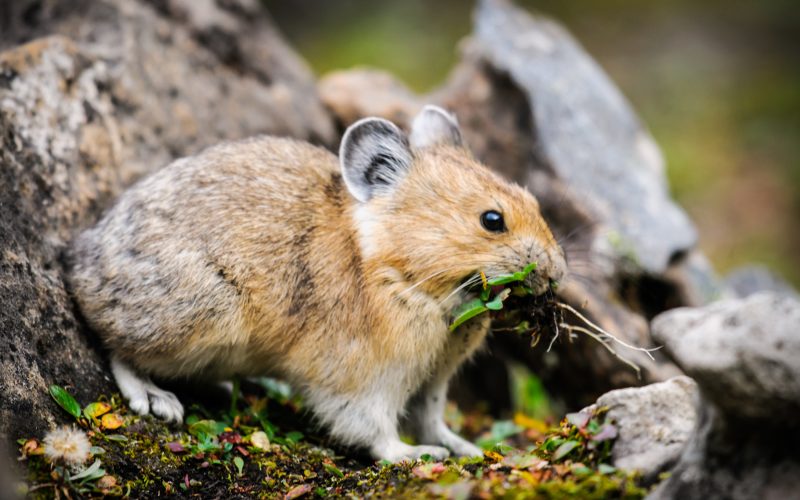Living above the clouds high on Rocky Mountain peaks is a rabbit relative to the size of a tennis ball, with a fur coat that insists upon wintery temperatures. Their cute, rounded shape and electrifying personalities are not altogether unlike the famous Pikachu from the popular Pokémon games and television series.
These plump boulder bunnies have many natural enemies, especially weasels which hunt them. They’re at the bottom of the food chain, playing an important role in the sustenance of other species which all live symbiotically in the mountain ecosystem. Instead of hibernating, American Pikas spend warmer months collecting grass and flowers (imagine a round-eared rabbit hopping around with a bouquet in its mouth) drying the plants in the sun to make hay which is stored in burrows under the rocks. A study done in 1990 showed that these underground hay larders can weigh up to 61 pounds, cover an area of 100 square meters, and can reach up to two feet high. “Biologists have learned that during just a 10-week time period, one pika will make 14,000 foraging trips, as many as 25 per hour, to secure its food stash.”
Some like it hot, pika like it cold. Their habitats are fragmented because they can only survive on mountain peaks, where temperatures stay chilly year-round – or they used to, anyway. Higher temperatures above 80 degrees Fahrenheit can cause death by overheating within 30 minutes. Each pika population depends upon islands in the sky, and those islands are shrinking due to climate change, which might be threatening the pika.
A 2003 study, published in the Journal of Mammalogy, showed nine of 25 sampled populations of American pika had disappeared in the Nevada Great Basin. It was almost considered a candidate for the endangered species list, but is still listed as a species of least concern.
According to Amy Seglund, a species conservation biologist for Colorado Parks and Wildlife, American Pika are not declining. Since 2008, Seglund has been studying pika populations, and found that in 62 historical pika locations, they are still present in 90 percent of them. Seglund explained the contradiction in pika studies: “The mountains in the Great Basin are much different than Colorado’s: They are at a lower altitude, provide limited contiguous habitat, receive less moisture and hold warmer temperatures. In Colorado there’s more available habitat, more moisture, and the summer-time temperatures are cool enough for pika to thrive.” Pika populations are staying steady in that state.
In a 2010 study, the USDA Forest Service reported that “scientists found that pika persist in a wider range of temperatures than previously discovered” and appeared to be thriving, capable of adapting in warmer areas. But a 2015 study published in the Journal of Biology surveyed pika populations in California’s Cascade and Sierra Nevada mountain ranges and discovered that pika were absent from fifteen percent of their historical ranges in lower elevations.
While certain populations seem to be disappearing, one thing that’s here to stay is our love affair with pikas. As long as humans take an interest in their well-being, pikas will be protected.
Amanda Bancroft is a Master Naturalist and volunteers with her husband Ryan for their solar-powered online educational center on how to make a difference with everyday choices at: www.RipplesBlog.org.











